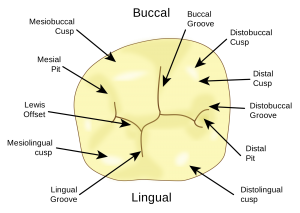Have you ever thought about the different surfaces of your teeth? We think that if our patients have a better understanding of the surfaces of their different tooth types, it will help them to be more aware of how thorough they are reaching all of the surfaces during daily brushing and flossing!
Some Dental Vocabulary
Buccal = cheek side of teeth
Lingual = tongue side of teeth
Occlusal = biting surfaces of back teeth
Incisal = biting or “incising” surfaces of front teeth
Pit and Grooves = small indentations and grooves in teeth
Cusp = raised area of teeth
Buccal and Lingual Surfaces (Cheek and Tongue side) of Your Teeth
The buccal (or cheek-side) of your teeth are usually smooth. One exception is that your lower molars may have buccal pits. The lingual (or tongue-side) of your teeth are also usually smooth, this time with an exception of upper molars that often have lingual grooves ending in a pit. Some upper front teeth might have lingual pits, as well.
Occlusal and Incisal Surfaces (Biting side) of Your Teeth
All premolars and molars (your back teeth) have pits and grooves on the occlusal (biting) surfaces. The occlusal surfaces also contain tooth cusps, or raised areas. Canines are called “cuspids” because they have one cusp each. Premolars are called “bicuspids” because they typically have two cusps each. And molars usually have four or five cusps each. The cusps of premolars and molars surround the pits and grooves of these teeth. The incisal surfaces are the biting surfaces of your front teeth. They may show a small hint of cusp development, however incisal edges are usually without pits and grooves and are easy to clean.
Why It Matters
Smooth surfaces of teeth clean easily, and your mouth even performs a lot of self-cleaning on these surfaces throughout the day. Your tongue movement and salivary flow help to clean these smooth areas of food particles and bacteria. The more difficult to clean areas are your pits and grooves, between your cusps, so that is where you need to focus your brushing. The most common places where plaque tends to stay trapped and where tooth decay tends to start are:
- Right along the gum line
- In the pits and grooves
- Between the teeth at the contact point where one tooth touches the other (the tightest spot)
So, keeping all of your new tooth surface knowledge in mind, we hope you are able to understand a little better why thorough brushing after each meal (really focusing on those pits and grooves!) and flossing at the end of the day (to get plaque out of those tight spaces) are so important to your dental health!
Some additional tips:
- Try a disclosing agent to help you keep track of how well you are cleaning all of your surfaces so that you can make improvements as needed.
- Make sure you are following best practices in your oral hygiene to improve preventive measures of daily brushing, flossing, and rinsing.
- Follow tips for effective flossing to really get plaque out of those hard-to-reach places!
Photo courtesy of Fred the Oyster via Wikimedia Commons

